International Journal of Scientific & Engineering Research, Volume 5, Issue 7, July-2014 245
ISSN 2229-5518
OPTIMUM TILT FOR SOLAR COLLECTORS IN RAJSHAHI, BANGLADESH
1Debazit Datta, 2Md. Jamal Hossain, 3Bimal Kumar Datta
Abstract: Incident solar irradiation of photovoltaic collector is affected by tilt and azimuth angles. This study measures the optimum tilt and azimuth angles for Photovoltaic Applications at Rajshahi in Bangladesh on yearly and seasonal bases. The result shows optimum tilt angles for PV applications. This study finds that optimum tilt angle is as the local latitude at Rajshahi for grid connected PV system to obtain maximum yearly energy generation where energy increment rate is 8.1% than horizontal radiation. Seasonal optimum tilt is found as 50 degree for months November-February and 10 degree for months April-September, 30 degree for March & October. Energy produced is 4.4% more than that of annual optimum tilts.
Keywords: Energy policy, tilted radiation, optimum tilt, surface orientation, annual tilt, seasonal tilt, increment rate.
-------------------------------------------------------------------------------------------------------------------
INTRODUCTION:
The techniques for estimating typical solar radiation on tilted surfaces of various directions can be used to show the special effects of slope and azimuth angle on total energy received on a surface on a monthly, seasonal or annual basis. The surface direction leading to highest output of a solar energy structure may be fairly different from the orientation leading to maximum incident energy. For solar energy purposes, the most favorable orientation is usually recommended to be south facing in the northern hemisphere and the
optimum tilt depends simply on the local latitude, 𝛽𝑜𝑝𝑡 =
𝑓(𝜑). Duffie and Beckman [1] recommended that optimum
tilt is within the range (𝜑 ± 15 𝑑𝑒𝑔) ± 15𝑑𝑒where 𝜑 is the
local latitude.
----------------------------------------------------------------------------------------------------------------------------
1Department of Mathematics, International University of
RATIO OF BEAM RADIATION ON INCLINED TO THAT ON HORIZONTAL SURFACE:
The geometric factor, 𝑅𝑏 , the ratio of beam
radiation on the tilted surface to that on a horizontal

surface at any time, can be calculated exactly from the following equation. Figure 1 indicates the angle of incidence of beam radiation on the horizontal and tilted surfaces [1].
Figure 1: beam radiation on horizontal and tilted surfaces
[1].
The ratio is given by
Business Agriculture and Technology, Bangladesh.
𝑅𝑏 =

𝐺𝑏,𝑇 =
𝐺𝑏

𝐺𝑏,𝑛 𝑐𝑜𝑠𝜃 =
𝐺𝑏,𝑛 𝑐𝑜𝑠𝜃𝑧

𝑐𝑜𝑠𝜃
𝑐𝑜𝑠𝜃𝑧
(1)
2Department of Applied Mathematics, Noakhali University of
Science and Technology, Bangladesh.
3Department of Mathematics, Pabna University of Science and
Technology, Bangladesh.
Christensen and Barker [4] found that surface tilt angles and azimuth angles can be varied over a significant range without considerably dropping the amount of yearly incident irradiation.
where,
𝑐𝑜𝑠𝜃 = 𝑠𝑖𝑛𝛿 𝑠𝑖𝑛𝜑 𝑐𝑜𝑠𝛽 − 𝑠𝑖𝑛𝛿 𝑐𝑜𝑠𝜑 𝑠𝑖𝑛𝛽 𝑐𝑜𝑠𝛾
+ 𝑐𝑜𝑠𝛿 𝑐𝑜𝑠𝜑 𝑐𝑜𝑠𝛽 𝑐𝑜𝑠𝜔
+ 𝑐𝑜𝑠𝛿 𝑠𝑖𝑛𝜑 𝑠𝑖𝑛𝛽 𝑐𝑜𝑠𝛾 𝑐𝑜𝑠𝜔
+ 𝑐𝑜𝑠𝛿 𝑠𝑖𝑛𝛽 𝑠𝑖𝑛𝛾 𝑠𝑖𝑛𝜔
and 𝑐𝑜𝑠𝜃𝑧 = 𝑐𝑜𝑠𝜑 𝑐𝑜𝑠𝛿 𝑐𝑜𝑠𝜔 + 𝑠𝑖𝑛𝜑 𝑠𝑖𝑛𝛿
The best azimuth angle for solar collectors is usually 00 in
the northern hemisphere. Thus, upon simplification
equation (1) reduces to
cos(𝜑 − 𝛽) 𝑐𝑜𝑠𝛿 𝑐𝑜𝑠𝜔 + sin(𝜑 − 𝛽) 𝑠𝑖𝑛𝛿
Prior to this work, a study was done to find the
optimum orientation of solar collectors at Dhaka,
𝑅𝑏 =
𝑐𝑜𝑠𝜑 𝑐𝑜𝑠𝛿 𝑐𝑜𝑠𝜔 + 𝑠𝑖𝑛𝜑 𝑠𝑖𝑛𝛿

(2)
Bangladesh and has been found 30 degree for optimum tilt
But according to Liu and Jordan [10] �𝑅� is calculated from
𝑐𝑜𝑠(𝜑 − 𝛽)𝑐𝑜𝑠𝛿𝑠𝑖𝑛𝜔𝑠 + �𝜋� �𝜔𝑠 𝑠𝑖𝑛(𝜑 − 𝛽)𝑠𝑖𝑛𝛿
at that location [11]. Then this study aims to check any
difference in optimum tilt at Rajshahi where solar radiation
𝑅� 𝑏
180
𝑐𝑜𝑠𝜑𝑐𝑜𝑠𝛿𝑠𝑖𝑛𝜔𝑠 + �𝜋�180�𝜔𝑠 𝑠𝑖𝑛𝜑𝑠𝑖𝑛𝛿
(3)
intensity is maximum than any other locations of
Bangladesh [12].
Where, 𝜔𝑠 denotes the sunset hour angle and is taken to the
smaller value from
IJSER © 2014 http://www.ijser.org
International Journal of Scientific & Engineering Research, Volume 5, Issue 7, July-2014 246
ISSN 2229-5518
𝜔𝑠 = 𝑐𝑜𝑠 −1 (−𝑡𝑎𝑛𝜑𝑡𝑎𝑛𝛿)
𝜔𝑠 = 𝑐𝑜𝑠−1 (−𝑡𝑎𝑛(𝜑 − 𝛽)𝑡𝑎𝑛𝛿)
(4)

𝐻�
𝐻� = 1.391 − 3.560𝐾�
+ 4.189𝐾� 2
− 2.137𝐾� 3
(6)
METHODOLOGY FOR THE OPTIMUM TILT:
We now calculate the tilted radiation when the total
And for 𝜔𝑠 > 81.40 and 0.3 ≤ 𝐾�
�

𝑑
≤ 0.8
3
horizontal radiation is known. For this we require the
𝐻� = 1.311 − 3.022𝐾� � �
directions from which the beam and diffuse parts arrive at
𝑇 + 3.427𝐾𝑇
− 1.821𝐾𝑇
(7)
the surface. The direction from which diffuse radiation is
For known 𝑅𝑏 and 𝐻𝑑 ⁄𝐻
ratio, monthly average daily
received, i.e., its circulation over the sky dome, is a function
of conditions of cloudiness and atmospheric clarity, which
are mostly unpredictable.
The tilted radiation is the sum of a set of radiation streams
including beam radiation, the three parts of diffuse flux
from the sky, and radiation reflected from the different surfaces seen by the tilted surface. The total radiation on this surface can be written as
� � = 𝐻� �1 − 𝐻𝑑 � 𝑅� � + 𝐻�� �1 + 𝑐𝑜𝑠𝛽 �
radiation on tilted surface was calculated.
For a fixed orientation, the optimum tilt angle can be found
by solving the following equation for 𝛽
𝑑

(𝐻� � ) = 0 (8)
𝑑𝛽 𝑇
Now, since diffuse and ground reflected parts are
negligible, the above equation turns into


𝐻� 𝑇
𝐻�
𝑏 � 𝑑 2
𝑑
(𝑅� �) = 0 (9)
+ 𝐻�𝜌𝑔 �

1 − 𝑐𝑜𝑠𝛽
2 � (5)

𝑑𝛽 𝑏
Where, 𝐻� 𝑑
is the monthly average daily diffuse radiation,
𝑠𝑖𝑛(𝜑 − 𝛽)𝑐𝑜𝑠𝛿𝑠𝑖𝑛𝜔𝑠 − �𝜋�180�𝜔𝑠 𝑐𝑜𝑠(𝜑 − 𝛽)𝑠𝑖𝑛𝛿
� �is the monthly average daily geometric factor for beam radiation, 𝛽 is the slope of the surface and 𝜌𝑔 is the diffuse
⇒
𝑐𝑜𝑠𝜑𝑐𝑜𝑠𝛿𝑠𝑖𝑛𝜔𝑠

+ �𝜋�180
= 0
�𝜔𝑠 𝑠𝑖𝑛𝜑𝑠𝑖𝑛𝛿
reflectance for the total solar radiation of the location.The
−1 (𝜋⁄180)𝜔𝑠 𝑠𝑖𝑛𝛿

surface view factor to the sky is �1+𝑐𝑜𝑠𝛽� and the surface
2
⇒ 𝛽 = 𝜑 − 𝑡𝑎𝑛
�
𝑐𝑜𝑠𝛿 𝑠𝑖𝑛𝜔𝑠
� (10)

view factor to the ground �1−𝑐𝑜𝑠𝛽�

2
Figure 2: Beam, diffuse and reflected solar radiation on tilted surface [1]
The first step to calculate the average monthly tilted solar
radiation is to calculate 𝑅𝑏 using equation (3) and the relationship 𝐻𝑑 ⁄𝐻 from the measured data or using any of
the correlation models. Equations considered in this study
for these correlations are as follows [9]:
For fixed values of 𝜑, 𝜔𝑠 and 𝛿 for a particular month at a specific location, the optimum tilt angle is easily
determined.
RESULTS AND DISCUSSION
TOTAL ENERGY RECEIVED ON ANNUAL BASIS:
Finding the local annual optimum tilt angle is significant in determining the optimum orientation. The maximum energy obtained at south facing azimuth angle with latitude oriented slope as shown in figure 4. Compared with horizontally placed PV collectors, the modules with optimum slope can generate 8.1% more power. Upon determined the tilt factors by using equation (3), figure 3
For 𝜔𝑠 ≤ 81.40and 0.3 ≤ 𝐾�
≤ 0.8
presents graphically for the months for different
orientations.
Table 1: Tilt factor and monthly average tilted radiation for latitude oriented and optimum oriented for annual optimum power
output
(𝛽 = 30 )
IJSER © 2014 http://www.ijser.org
International Journal of Scientific & Engineering Research, Volume 5, Issue 7, July-2014 247
ISSN 2229-5518
| (𝛽 = 200 ) | radiation (𝑀𝐽⁄𝑚2) | | (𝑀𝐽⁄𝑚2) | | |
Jan | 1.39 | 15.71 | 1.46 | 16.2399 | 1.52 | 16.6726 |
Feb | 1.26 | 22.35 | 1.3 | 22.8417 | 1.33 | 23.1659 |
Mar | 1.12 | 21.55 | 1.13 | 21.6374 | 1.13 | 21.5650 |
Apr | 1 | 21.89 | 0.98 | 21.5354 | 0.95 | 20.9974 |
May | 0.91 | 19.39 | 0.89 | 19.0882 | 0.84 | 18.3830 |
Jun | 0.88 | 19.27 | 0.84 | 18.7113 | 0.79 | 17.9821 |
Jul | 0.89 | 16.59 | 0.86 | 16.2478 | 0.81 | 15.6744 |
Aug | 0.96 | 15.44 | 0.94 | 15.2117 | 0.91 | 14.8611 |
Sep | 1.07 | 17.55 | 1.07 | 17.4888 | 1.06 | 17.2905 |
Oct | 1.21 | 19.38 | 1.24 | 19.6551 | 1.27 | 19.8903 |
Nov | 1.35 | 19.90 | 1.41 | 20.5721 | 1.47 | 21.2275 |
Dec | 1.43 | 14.72 | 1.5 | 15.2269 | 1.58 | 15.7844 |
Annual total | | 6791.72 | | 6811.32 | | 6781.34 |
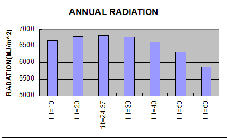
annual total tilted radiation for different tilts, where it has been found that for tilt equal to local latitude, the annual total solar radiation is highest.
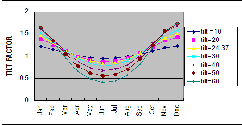
Figure 5: Annual total solar radiation (𝑀𝐽⁄𝑚2) vs tilt
Figure 3: Tilt factor vs months of year for fixed slope
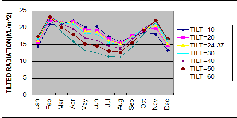
Figure 4: solar radiation (𝑀𝐽⁄𝑚2 ) vs months for fixed orientation throughout the year
The yearly collected solar radiation reduces sharply when the slopes exceed 40 deg. Figure 5 shows bar charts of
Total energy received on seasonal basis:
If we divide the whole year into two different categories on the basis of high and low tilt factor then we get an optimum tilt angle as 50 degree for the months November-February,
10 degree for the months April-September and 30 degree
for the months March & October. Energy obtained in this
case is 4.4% more than the energy obtained for annual optimum tilt.

Figure 6: Tilt factor vs months of year for variable slope (Tilt for Apr-Sep is 10 degree and Nov-Feb is 50 degree and for March & October 30 degree)
IJSER © 2014 http://www.ijser.org
International Journal of Scientific & Engineering Research, Volume 5, Issue 7, July-2014 248
ISSN 2229-5518
Seasonal optimum | 7111.12 | 12.85% | 4.4% |
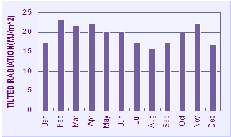
Figure 7: Tilted Solar radiation (𝑀𝐽⁄𝑚2 ) vs months of year for variable slope (Tilt for Apr-Sep is 10 degree and Nov-
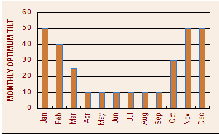
Feb is 50 degree and for March & October 30 degree)
Figure 8: Optimum tilt for different months of the year
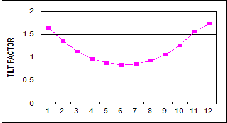
Figure 9: Tilt factors vs months for monthly optimum tilt
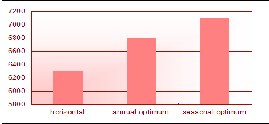 Figure 10:
Figure 10:
energy (𝑀𝐽⁄𝑚2) output for three different orientations
It is seen from figure 10 that maximum power is generated
for monthly optimum tilt. Seasonal tilt energy output is nearly equal to that of monthly output.
Table 3: Energy increment rate at different orientations
Table 3 shows the increment rate of power produced over different types of surface orientations for annual fixed, seasonal fixed and monthly variations.
Annual optimum (𝛽 = 24.370 ) energy is increased at a rate of 8.1% than horizontal orientation. Seasonal (𝛽 = 100 for Apr-Sep and 500 for Nov-Feb and 300 for March &
October) optimum energy is increased 4.4% than annual
optimum energy obtained.
CONCLUSION:
The efficiency and performance of solar collectors and Photovoltaic systems depend on the module’s orientation. The Photovoltaic collectors should be tilted in an appropriate manner to obtain the utmost radiation. In this study it is found that optimum tilt angle in Rajshahi is
equal to the local latitude of 𝜑 = 24.37 𝑑𝑒𝑔 for both stand
alone and grid connected PV system to obtain maximum
yearly energy generation. Seasonal optimum tilt reaches to
50 degree for months (November-February) and 300 for
March & October and 10 degree for months (April -
September). If the slopes could be adjusted monthly, the
power efficiency would likely be much better.
REERENCES
[1]Duffie J. A., and Beckman. W.A., 1980, Solar Engineering of
Thermal processes, John Wiley & Sons, New York.
[2] Lewis. G., 1987, Optimum Tilt of Solar Collectors, Solar and
Wind Energy, 4, pp, 407-410.
[3] Asl-Soleimani, E., Farhangi, S., and Zabihi, M.S., 2001, The
Effect of Tilt Angle and Air Pollution on Performance of
Photovoltaic Systems in Tehran, Renewable Energy, pp. 459-
468.
[4] Christensen. C.B. and Barker. G. M., 2001, Effects of Tilt and Azimuth on Annual Incident Solar Radiation for United States Locations, Solar Engineering 2001, the Power to Choose April
21-25, Washington, DC.
[5] Hongxing Yang and Lin Lu, The Optimum Tilt Angles and Orientations of PV Claddings for Building –Integrated Photovoltaic (BIPV) Applications, Journal of Solar Energy Engineering, May 2007, Vol. 129/ 253.
[6] H. R. Ghosh, N. C. Bhowmik, M. Hussain, “Determining
seasonal optimum tilt angles, solar radiations on variously oriented, single and double axis tracking surfaces at Dhaka”, Renewable Energy, vol. 35, no.6, June 2010, pp. 1292–1297.
[7] Country Report of Solar and Wind Energy Resource
Assessment, Bangladesh, supported by UNEP, GEF.
[8] NASA surface Meteorology and Solar Energy.
[9] Collares Pereira, M and A. Rabl, Solar Energy, 22, 155
(1979a), The Average Distribution of Solar radiation – Correlations between Diffuse and Hemispherical and between Daily and Hourly Insolation Values.
IJSER © 2014 http://www.ijser.org
International Journal of Scientific & Engineering Research, Volume 5, Issue 7, July-2014 249
ISSN 2229-5518
[10] B.Y.H. Liu and R.C. Jordan, the interrelationship and characteristic distribution of direct diffuse and total solar radiation, Solar energy, 1960, 4(3), 1-19.
[11] Debazit Datta, Dr. Himangsho Ranjan Ghosh, Saadia Binte Alam, Utpal Kanti Das, Arijit Sen, Surface orientations and Energy Policy for Solar Module Applications in Dhaka, Bangladesh, International Journal of Scientific and Engineering Research, Volume 5, Issue 2, February 2014, 283-288.
[12] Debazit Datta, Suman Chowdhury, Apurba Kumar saha, Md. Moksud Islam Lalan, Mohammad Mahbubur Rahaman, Tilted and Horizontal Solar Radiation for 6 zones in Bangladesh, International Journal of Scientific and Technology Research, volume 3, issue 2 February 2014, 92-96.
IJSER © 2014 http://www.ijser.org









